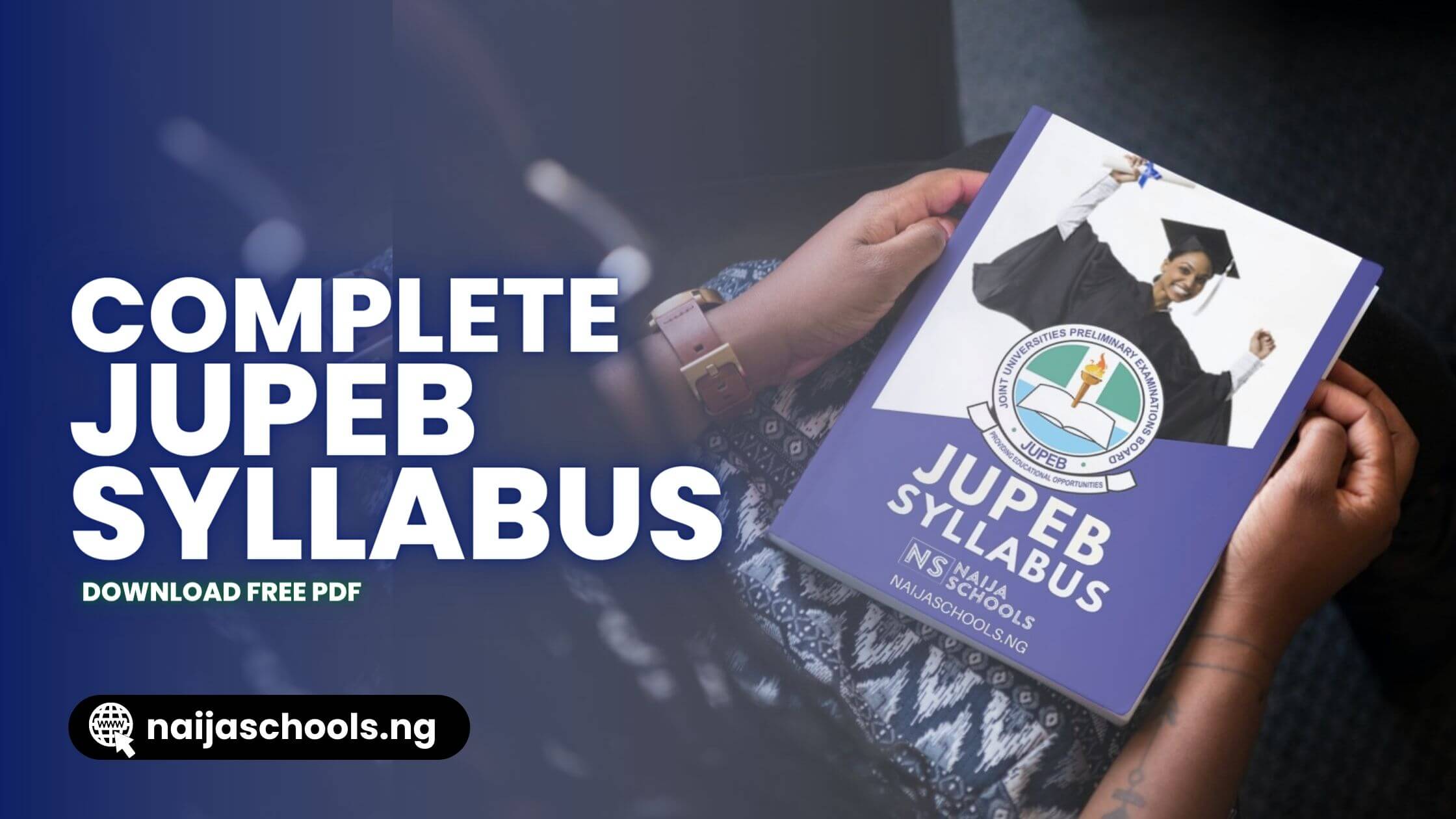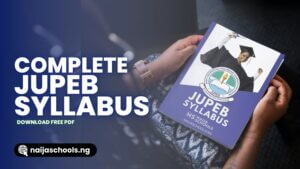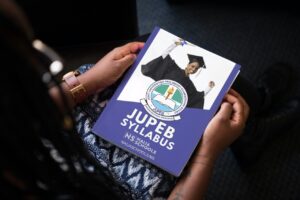The Islamic Studies JUPEB Syllabus covers the four principal areas of Islamic Studies, namely:
(i) Ta’rīkh (Islamāic History)
(ii) The Qur’ān
(iii) Hadīth
(iv) Fiqh (Islamic Jurisprudence)
Objectives of the Islamic Studies JUPEB Syllabus
Candidates, at the end of this programme should be able to:
- Discuss the principles of Islam as a religion as well as the sources of its tenets.
- Evaluate the history of Islam in the context of the significance of various events characterizing the life of Muhammad (PBUH) and the achievements of the Khulafāur-Rā shidūn.
- Appraise the main features of the Qur’ān and its emergence as a divine book.
- Analyse the social, moral, political and economic dimensions of various forms of worship in Islam.
- Discuss the basic technicalities involved in the study of Hadīth and the values of its literature.
Courses:
The Islamic Studies JUPEB Syllabus covers two semesters is structured into four courses as follows:
FIRST SEMESTER
- ISS 001: History of Islam (3 Units)
- ISS 003: Qur’ānic Studies (3 units)
SECOND SEMESTER
- ISS 002: Tawhīd and Ibādāt (3 Units)
- ISS 004: Introduction to the Study of Hadīth (3 Units)
Course Description
ISS 001: History of Islam (3 Units)
This course critically examines the history of Islam covering the Jāhiliyyah period, the biography of Muhammad and the Khulafa’ Rāshidūn. An overview of the Umayyad and `Abassid dynasties is presented with focus on the caliphates of `Umar ibn `Abdul-`Azīz and Hārūn Ar-Rashīd. The course also studies the impact of the spread of Islam to West Africa with reference to the roles of traders, scholars, political leaders and Muslim groups. Contemporary practice of Islam is appraised in the context of Muslim-non-Muslim interaction.
Objectives
Students should be able to:
- Classify the history of Islam into various periods and examine the vital features of each period,
- Justify the relevance of the biography of Muhammad as to the effective study of the sources of Islam and its teachings,
- Compare and contrast developments in Islamic history from one period to another.
- Establish through critical analysis the significance of important events in the Islamic history
- Discus the relevance of the biographies of Muslim personalities to the contemporary world.
Course Outline
- An Appraisal of the Jāhiliyyah Period and the Significance of the Islamic Reforms.
- The Biography of Muhammad
- Life and Achievements of the Khulafā’ Rāshidūn
- An overview of the Umayyad and `Abassid dynasties
- Life and Achievements of `Umar ibn `Abdul-`Azīz
- Life and Achievements of Life and Achievements of Hārūn ar-Rāshīd
- Impact of the spread of Islam to West Africa
- The Hausa-Fulani Jihād
- The Kanem-Bornu Empire.
- Muslim-Non- Relations
ISS 002: Tawhīd and Ibādāt (3 Units)
The course is structured into two main parts, namely; Islamic monotheism and basic forms of worship.
The aspect on tawhīd covers basic traditional discussions on the Islamic concept of monotheism with reference to the branches of faith (i.e. faith in Allah, His Attributes, Allah’s Prophets, Allah’s Books, Angels, the Last Day and Qadar.) and the implications of kufr.
The aspect on Ibadat (Forms of Worship) exposes students to the types and purposes of taharah (purification), detailed analyses of the observance and values of Islamic rituals including Salāt, Zakāt, Sawm and Hajj. The concept of Zawāj and Talaq including the conditions surrounding them.
Objectives
Students should be able to:
- Analyse the various dimensions of Tawhīd (Unity of Allah)
- Discuss the typologies of shirk (Polytheism)
- Appraise the belief in Angels, Prophets, Scriptures, Last day and Qadar
- Compare the features of the primary and secondary Sources of Sharī`ah
- Discuss the Islamic concept of Ibādah
- Perform the various forms of Tahārah
- Analyse the values of Islamic rituals including Salāt, Zakāt, Sawm and Hājj
- Evaluate the rules regulating both Zawāj and Talāq
Course Outline
- Definition and Types of Tawhīd (Tawhīd ar-Rubūbiyyah, Tawhīd al-Ilāhiyyah and Tawhīd al-Asmā’ was-Sifāt).
- Types and Implications of Shirk
- An Analysis of the Names and Attributes of the Qur’ān.
- Comparison of features of the primary and secondary Sources of Sharī`ah
- Nature and Implication of Engaging in Different Forms of Shirk
- The Islamic concept of Ibādah
- Forms and Purposes of Tahārah
- The Observance, Types and Values of Salāt
- The Regulations Governing Zakat and Sadaqah and the values of both
- The Regulations Governing Sawm, Types of Fasts and the Significance of fasting
- The Conditions, Performance and performance of Hājj and `Umrah
- The Islamic Marriage and Divorce and comparison with Marriage and Divorce Practices in other Cultures.
ISS 003: Qur’ānic Studies (3 Credits)
The course extensively highlights the attributes and inimitability of the Qur’ān as a divine scripture. It discusses the various modes of revelation, mechanisms of preserving the Qur’ānic text, its arrangement compilation and the emergence of the Uthmanic Copy.
The major themes of the Makkī and Madanī suwar are analysed. A study of the text, translation and detailed commentary on selected chapters of the Qur’ān in the Juz’ `Amma reflecting the views of popular Mufassirun (such as Al-Jalālayn and Ibn Kathīr), their application to contemporary issues. Attempt is made to introduce Basic Qur’anic literacy to facilitate effective study of Arabic texts.
Objectives
Students should be able to:
- Justify the authenticity of the Qur’ān as a divine book.
- Differentiate between revelation rand compilation of the Qur’ān.
- Evaluate the necessity for the Uthmānic Copy of the Qur’ān.
- Establish the distinction between the Makkī and Madanī suwar
- Interpret the Juz’ `Amma using the commentaries of Al-Jalālayn and Ibn Kathīr as a guide.
- Qur’anic Arabic (the Arabic sound system, transliteration methods, basic structure of Arabic sentences).
Course Outline
- Analysis of the Names and Attributes of the Qur’ān.
- Authenticity of the Qur’ān as a Divine Book
- Modes of Revelation
- Arrangement and Means of Preserving the Qur’ānic Text
- The Emergence of ar-Rasm al-`Uthmānī
- The Distinction between the Makkī and Madanī suwar
- Asbābun-Nuzūl and an-Nāsikh wal-Mansūkh
- Ethics of Interpreting the Qur’ān
- A Study of the Text, Translation and Interpretation of the Juz’ `Amma.
ISS 004: Introduction to the Study of Hadīth (3 Units)
This course introduces students to the definition of Hadīth, its basic form (Isnād and Matn), types (Nabawi and Qudusi) and significance as the second primary source of Islamic tenets.
It examines the history of the development of Hadīth focusing on the roles of the ruwāt and the muhaddithūn. A detailed study of Asmaur-Rijāl, classifications of Hadīth, important features of the six authentic Hadīth collections and textual analysis of the collections of An-Nawawi and selected ahadīth from al-Bukhārī.
Objectives
Students should be able to:
- Distinguish between Hadīth and Sunnah
- Classify Hadīth into various categories.
- Analyse the basic form of the Hadīth
- Discuss the process of the emergence of Hadīth literature
- Explain basic terms used in the Science of Hadīth.
- Interpret the Ahādīth contained in the an-Nawawi’s collection
Course Outline
- Definition and Values of Hadīth
- The Relationship between Hadīth and Sunnah
- Types of Hadīth (Nabawī and Qudus)
- Basic Form of the Hadīth (Isnād and Matn)
- Determining the Authenticity of Hadīth ()
- The Ruwāt and the Muhadīthūn
- The Six Standard Works and Biographies of Compilers
- The Mu`jam of at-Tabarānī and Jami` of Ibn `Athīr
- Textual Analyses of an-Nawawi’s Collection
- A Critical Appraisal of Sahīh al-Bukhārī
Reading List
- Abdul, M.O.A. The Classical Caliphate. Lagos: Islamic Publications Bureau.
- Ali, Abdullah Yusuf. The Holy Qur’ān: Text, Translation and Commentary. Washington, DC: Amanah, 1989.
- Ali, Maulana M., The Religion of Islam.eBookit.com, 2011.
- Ash-Sharif, Muhammad M. Ibn Kathīr Tafsīr. 10 Vols. Riyadh: Darus-Salam Publications, 2000.,
- Bell, Richard. Introduction to the Qur’ān. Edinburgh: Edinburgh University Press, 1963.
- Burton, John. An Introduction to the Hadīth. Edinburgh: Edinburgh University Press, 1994.
- Doi, `Abdur-Rahman I. Sharī`ah: Islamic Law. London: Tā Publishers, 2008.
- Fawzan, Sālih, A Summary of Islamic Jurisprudence. 2 Vols. Riyādh: Al-Maiman Publishing House, 2009
- Hamidullah, M. Introduction to Islam. Ankara: Turkiye Diyanet Vakfi, 1997.
- Haykal, M. H. The Life of Muhammad. Plainfield: American Trust Publications, 2005.
- Hitti, Philip K. History of the Arabs: From Earliest Times to the Present. London: Macmillan, 10th ed., 2002.
- Hiskett, Mervyn. The Development of Islam in West Africa. London: Longman, 1984.
- Holt, P.M., et al., eds. Cambridge History of Islam, 2 Vols. Cambridge, UK: Cambridge University Press, 1970.
- Khan, Muhammad Muhsin, Translation of Sahih al-Bukhari. Ankara: Hilal Yayinlari, 1976.
- Phillips, Bilal, Usoolul-Hadeeth. Riyādh: International Islamic Publishing House, 2007.
- Trimingham, J.S. Islam in West Africa. Oxford, UK: Clarendon Press, 1959.
- Watt, William Montgomery. Muhammad at Mecca. Oxford, UK: Clarendon Press, 1953.
- Watt, William Montgomery. Muhammad at Medina. Oxford, UK: Clarendon Press, 1956.
- Zarabozo, J. Commentary on the Forty 40 Hadīth of an-Nawawī. 2 Vols. Denver: Al-Basheer Company for Publications and Translation, 2010.
Download the Islamic Studies JUPEB Syllabus (PDF)
Click on the “Download” button to download the JUPEB syllabus for Islamic Syllabus in PDF format.
Recommended Articles
- JUPEB Syllabus For All Subjects — Free PDF Download
- CRS JUPEB Syllabus — Free PDF Download
- French JUPEB Syllabus — Free PDF Download
- History JUPEB Syllabus — Free PDF Download
- Igbo JUPEB Syllabus — Free PDF Download
- Islamic Studies JUPEB Syllabus — Free PDF Download
- Literature in English JUPEB Syllabus — Free PDF Download
- Music JUPEB Syllabus — Free PDF Download
- Visual Arts JUPEB Syllabus — Free PDF Download
- Yoruba JUPEB Syllabus — Free PDF Download
- IJMB Syllabus For All Subjects — Free PDF Download




